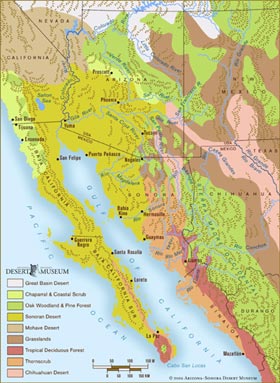Desert Museum Science and Conservation
regional knowledge for nature and people
The future of the Sonoran Desert region rests on our ability to adapt to a rapidly changing climate, which in turn rests on biologically diverse, resilient ecosystems. People are powerful as well as vulnerable participants in this system. For nearly 70 years, the Desert Museum has been helping people understand and appreciate their environment and their multiple roles in it. Museum scientists and curators documented and disseminated the foundation of natural history knowledge that underpins management decisions today, as it has in the past.
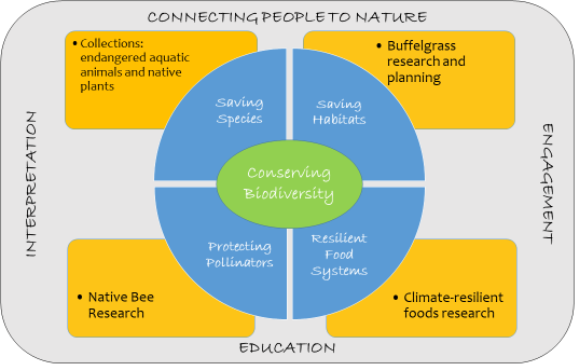
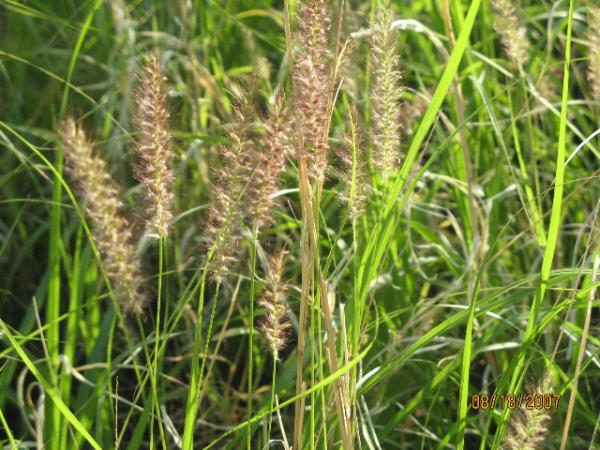
Saving Habitats
In the area of plant ecology, the Museum is currently focused on the science and management of invasive weeds, primarily buffelgrass, which currently has the greatest potential to transform our saguaro-palo verde forests into fire-prone grasslands, endangering biodiversity and human health and property. Building upon the Museum’s history of publishing the flora of vast areas of the Sonoran Desert – which have been used as the basis for decades of ecological research – we aim to expand into a more holistic approach to maintaining ecosystem function by understanding vegetation dynamics at the landscape scale under a regime of changing climate and introduced species. We are currently invested in research to better understand the impact of fire on saguaro mortality, to develop a bioherbicide from fungal pathogens, to monitor treatment effectiveness, and to understand how the actions and interactions among social actors (e.g., HOAs, government agencies, volunteer orgs, etc.) influence outcomes of the invasion. We will continue to work with partners at the University of Arizona and regional land managers to develop sustainable approaches for maintaining and restoring desert landscapes that continue to support biodiversity and mitigate the threat of fire for plants, wildlife, and people.
Read more...
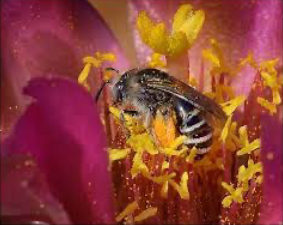
Protecting Pollinators
The Museum is currently focused on understanding the diversity and ecology of native bees. The region is one of the most bee-diverse in the world (along with the Middle East), with more than 700-800 species, yet we know very little about the needs and habits of these preeminent pollinators. Building on the Museum’s history with the Forgotten Pollinators and Migratory Pollinators projects, which brought attention to the need to protect these overlooked animals, The Desert Museum will continue working with colleagues at the University of Arizona to understand the current status of native bees, factors that affect their diversity and abundance, and actions that can help to conserve their populations and functions in our ecosystem. These efforts rely on a team of volunteer scientists, one of the Museum’s most valuable but underutilized assets. These volunteers sample, pin, label and identify every specimen, resulting in a collection of nearly 20,000 bees, which will be used for decades to answer questions about abundance, diversity, species composition, phenology, and the impacts of climate and other environmental change on native bees. Moreover, we continue to grow the educational component of this effort by offering college and high school students the opportunity to contribute by DNA barcoding bee specimens for which identification is impossible via morphological characters. Through DNA barcoding, students are documenting new species and publishing their barcodes in the Barcode of Life Database (BOLD), which helps them see themselves as scientists. Hundreds of additional community scientists are documenting native bees via photography and the Tucson Bee Collaborative iNaturalist Project. The Museum also participates in networks to monitor and conserve monarch butterflies at the national and state level, with monarch tagging and public education.
Read more...
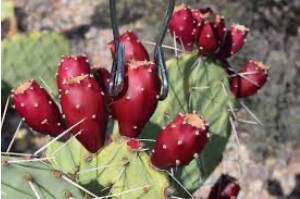
Resilient Food Systems
Building on a long history of ethnobotanical research, teaching, and outreach, the Museum aims to establish a research program to understand and conserve the wild relatives of modern-day crops and expand the regional food system to include arid-adapted native foods. These native and other arid-adapted plants are an important hedge against the effects of climate change in the Sonoran Desert and other arid regions. They can provide low-cost, low-maintenance food supplies for households and local producers as well as genetic material to adapt future large-scale agriculture to a changing climate. Beyond providing food for people, native plants are the base of the food web for wildlife and a healthy ecosystem. Valuable partners will include Native Seeds/Search, Mission Garden, UArizona, Tucson City of Gastronomy, Borderlands Restoration and other groups that are interested in this area and would welcome additional research capacity and a connection to education programming for hundreds of thousands of Desert Museum visitors.
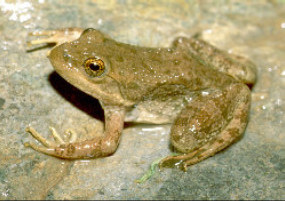
Saving Species
The Desert Museum works with State, Federal and Tribal agencies in both the US and Mexico to help conserve threatened and endangered species from the Sonoran Desert region. The Museum’s research in this area focuses on husbandry of aquatic species, although staff also participate in field surveys, reintroductions and research with some non-aquatic species as well. The Museum holds populations of plants, fish, amphibians and reptiles for the purposes of salvage, assurance and propagation. Knowledge developed at the Museum has led to the first successful breeding of several aquatic species, including, most recently, the Sonoyta mud turtle. Animals held at the Museum, and the knowledge developed about their care, contribute directly to the survival of the Sonoyta pupfish, Sonoyta mudturtle, Longfin dace, Gila topminnow, Sonoran Desert tortoise, Yaqui catfish, Sonora chub and Tarahumara frog, among others. The Museum also participates in Arizona Game and Fish’s Tortoise Adoption Program, involving citizens in saving this species.
Read more...
In each of the four focal areas, the Museum partners with university researchers, conservation practitioners, and land managers to answer questions and solve problems faced by communities today, and prepare for the anticipated and potential challenges of the future. The Museum is unique in its explicit linkage of science to a robust Art Institute and a multi-modal educational platform for increasing public understanding and engagement – which are as important as scientific knowledge for successful conservation programs. The Museum’s science team engages creatively with Museum educators and interpreters – including the award-winning docent program – to develop messaging for exhibits and programs, as well as opportunities for public participation, such as community science, pollinator and native-foods gardening, biodiversity surveys, buffelgrass pulls, and native-foods cooking classes. With its legacy of research on and interpretation of Sonoran Desert natural history in a setting that invites hands-on inquiry & connection, the Museum is poised to partner with academic, conservation, management, policy, and community organizations to make an enormous positive impact on the ecological and human systems of the region.
The Desert Museum is grateful for conservation funding from the Thomas R. Brown Foundation, National Park Service, US Forest Service, Bureau of Land Management, National Science Foundation, Institute of Museum and Library Services, National Forest Foundation, Arizona Department of Forestry and Fire Management, Pima County, the Rossetter Foundation, and anonymous foundations and donors
Selected References:
At least one author of every publication was on staff at ASDM at the time of publication.
Allen-Wardell, G., P. Bernhardt, R. Bitner, A. Burquez, S. Buchmann, J. Cane, P.A. Cox, V. Dalton, P. Feinsinger, M. Ingram, D. Inouye, C. E. Jones, K. Kennedy, P. Kevan, H. Koopowitz, R. Medellin, S. Medellin-Morales, G. P. Nabhan. (1998) The potential consequences of pollinator declines on the conservation of biodiversity and stability of food crop yields. Conservation Biology 12(1): 8-17.
Aslan, C.E. (2012-2013) The effect of a spatial shift on interspecific interactions: pollination of relocated vs. wild Arizona hedgehog cacti Final Report for Grant Number: Section 6, Segment 16 - 2012-2013
Aslan, C.E., E. S. Zavaleta, B. Tershy, and D. Croll. (2013) Mutualism disruption threatens global plant biodiversity: a systematic review. PLoS ONE 8: e66993.
Brenner, J.C. and K.A. Franklin. (2017) Living on the edge: emerging environmental hazards on the peri-urban fringe. Environment Magazine 59:16-29.
Buchmann, S.L. and G.P. Nabhan. (1997) The Forgotten Pollinators. Island Press, Washington D.C.
Delgado-Fernández, M., J.G. Escoboar-Flores, and K.A. Franklin. (2017) El cardon gigante (Pachycereus pringlei) y sus interacciones con la fauna en la peninsula de Baja California, México. (The Mexican giant cardon (Pachycereus pringlei) interactions with wildlife on the Baja California peninsula, Mexico. Acta Universitaria 27:3-12. doi:: 10.15174/au.2017.1274
Dimmitt, M.A., J.F. Wiens and T.R. Van Devender. (2005) Extreme succulent diversity in Central Baja California. In J.-L. E. Cartron, G. Ceballos and R. S. Felger (eds.), Biodiversity, Ecosystems, and Conservation in northern Mexico . Oxford Univ. Press.
Franklin, K., and C. Alsan. (2016) Pollination of Amsonia kearneyana in naturally-occurring, outplanted, and safe harbor populations. Final Report for Grant Number: Endangered Species Act Section 6, Segment 18 - 2014-2016-05.
Franklin, K.A., P.N. Sommers, C.E. Aslan, J.L. Bronstein, B.R. Lopez, E. Bustamante, A. Montijo-Burquez, R.A. Medellín, B. Marrazi. (2016) Plant biotic interactions in the Sonoran Desert: current knowledge and future research perspectives. International Journal of Plant Sciences 177:217–234.
Gornish, E.S., K.A. Franklin, J. Rowe, and A. Barberán. (2020) Buffelgrass invasion and glyphosate effects on desert soil microbiome communities. Biological Invasions 22:2587–2597. https://doi.org/10.1007/s10530-020-02268-8
Krebbs, K. Hummingbird Husbandry Manual. D. Rimlinger and M. Mace (eds.), AZA Taxon Advisory Group.
Li, Y. M., & Gornish, E. S. (2020). General attributes and practice of ecological restoration in Arizona and California, U.S.A., revealed by restoration stakeholder surveys. Restoration Ecology. https://doi.org/10.1111/rec.13221
Li, Y. M., Roche, L. M., & Gornish, E. S. (2020). Bridging the research-implementation gap in weed management on California rangelands. Rangeland Ecology & Management, 73(3), 348–357. https://doi.org/10.1016/j.rama.2020.01.007
Lien, A., E. Baldwin, and K. Franklin. (2021) Collective action in invasive species governance in southern Arizona. Rangeland Ecology and Management. 74: 151-164. https://doi.org/10.1016/j.rama.2020.10.004
Meyer, W.M, J. Eble, K. Franklin, R.B. McManus, S.L. Brantley, J. Henkel, P.E. Marek, W.E. Hall, C.A. Olson, R. McInroy, E.M. Bernal Loaiza, R.C. Brusca, and W. Moore. (2015) Ground-Dwelling Arthropod Communities of a Sky Island Mountain Range in Southeastern Arizona, USA: Obtaining a Baseline for Assessing the Effects of Climate Change. PLoS ONE 10(9): e0135210.
Nabhan, G.P. (2001) Nectar trails of migrating pollinators: Restoring corridors on private lands. Conservation Biology in Practice 2: 21-27.
Nabhan, G. P., (ed.) (2004) Conservation of Migratory Pollinators and Their Nectar Corridors in North America. Arizona-Sonora Desert Museum, Natural History of the Sonoran Desert Region, No. 2. University of Arizona Press, Tucson, Arizona.
Nabhan, G.P, E.C. Riordan, L. Monti, A.M. Rea, B.T. Wilder, E. Ezcurra, J.B. Mabry, J. Aronson, G.A. Barron-Gafford, J. Garcia, A. Burques, T. Crews, P.Mirocha, and W. Hodgson (2020) An Aridamerican model for agriculture in a hotter, water scarce world, Plants, People, Planet, July 29, 2020 https://doi.org/10.1002/ppp3.10129
Van Devender, T.R., F J. Espinosa-Garcia, B.L. Haper-Lore, and T. Hubbard (eds). (2009) Invasive Plants on the Move: Controlling Them in North America. Based on Presentations from from Weeds Across Borders 2006 Conference. Arizona-Sonora Desert Museum, Tucson, Arizona
Wilder, B. C. Jarnevich, E. Baldwin, J.S. Black, K.A. Franklin, P. Grissom, K.A. Hovanes, A. Olsson, J. Malusa, A.S.M.G. Kibria, Y.M. Li, A.M. Lien, A. Ponce. J.A. Rowe, J.R. Soto, M.R. Stahl, N.E. Young, J.L. Betancourt. (2021) Caught in the crossfire: grassification and fast evolving fire connectivity and risk in the Sonoran Desert, USA. Frontiers in Ecology and Evolution 9:1-20.
Zachmann, L., J.F. Wiens, K.A. Franklin. S.D. Crausby, V.A. Landau. (2021) Sonoran Desert species advanced flowering with increased growing degree days with diverging responses to changing moisture availability. Madroño 68: 473-486. https://doi.org/10.3120/0024-9637-68.4.473








